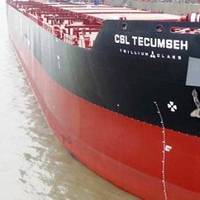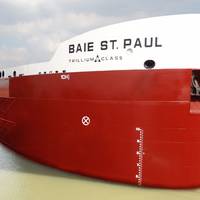CSL St-Laurent on Maiden Voyage
The second of Canada Steamship Lines' (CSL) two newbuild Trillium Class Great Lakes bulk carriers, CSL St-Laurent, was delivered on November 26, 2014 and set sail on her maiden voyage on December 13. She departed at 20:00 CST from Yangfan shipyard on Zhoushan Island, China, en route to Canada where she is set to operate throughout the Great Lakes and St. Lawrence River. The vessel is commanded by Captain Kevin Crouse and Chief Engineer Paul Beaudet, and is expected to take approximately 50-60 days to complete her voyage. CSL St-Laurent marks the successful completion of CSL's audacious newbuild program, which began with the delivery in December 2012 of the award-winning Trillium Class self-unloading Laker, Baie St. Paul.
CSL Tacoma Calls at Port of Redwood City

The final in a series of five Canada Steamship Lines' (CSL) state-of-the-art, new Trillium Class self-unloading Panamax vessels, the 228-meter long CSL Tacoma, embarked on her maiden voyage from the Chengxi Shipyard in Jiangyin, China on Oct. 12, and is making her maiden cargo voyage to San Francisco Bay. She is scheduled to arrive at the Port of Redwood City at noon on Wednesday, November 6, with sand and gravel construction materials from an Eagle Rock Aggregates quarry in British Columbia.
China-built, CSL's Fourth New Laker Homeward Bound

The last of Canada Steamship Lines’ (CSL) four newbuild Trillium Class self-unloading Lakers, the 'Baie Comeau', set sail June 30, on her maiden voyage from Chengxi Shipyard in Jiangyin, China, en route to Montreal, Quebec, for service on the Great Lakes & St. Lawrence Seaway. Commanding the Baie Comeau as she crosses the Pacific Ocean and transits through the Panama Canal is Captain Andriy Bondarenko, with Chief Engineer Francis Cotton. She is expected to take approximately 50-60 days to complete her voyage.
New Self Unloading Ship Calls at Port of Redwood City

New bulk ship CSL Tecumseh made its maiden voyage to the Port of Redwood City on Wednesday, May 29. Named after a respected war chief of the Shawnee Indians in the early 1800s, Tecumseh brought 40,000 tons of construction aggregates from the Orca Quarry in British Columbia. The material was delivered to Cemex Aggregates, a major port tenant. This is an essential material for ready-mix concrete plants from Santa Rosa to San Jose. The self-unloading Panamax-sized ship unloads all of its cargo of construction materials in 18-24 hours. The CSL Tecumseh is the sister ship to The Rt. Hon. Paul E.
CSL’s Trillium Class Sails for Great Lakes

The Baie St. Paul, Canada Steamship Lines’ first of four new Trillium Class self-unloading Lakers – and the most technologically advanced ship to enter the Great Lakes-St. Lawrence Seaway bulk shipping market – set sail today on her maiden voyage from Chengxi shipyard in Jiangyin, China to Montreal, Quebec. “Every first voyage of a new ship is an exciting event, but with the Baie St. Paul, the occasion is truly historic as CSL prepares to welcome the most modern vessel in the Great Lakes,” remarked Louis Martel, President of Canada Steamship Lines.
Specialties Cornerstone of Canadian Market
The past decade was a tough one for the Canadian shipbuilding market. It was a decade that produced a decline of both employment and decline of newbuilds, many of which were contracted in the late 1980s still awaiting construction. This unfinished business was concentrated mostly on various military projects that had been thought out but were never actually followed through. It is estimated that by the time the 1990's came to a close that Canadian yards had experienced the worst decade since postwar times with total sales declining by about 50 percent since 1991. In addition, total employment in the industry has broken off by about 50 percent from 12,000 workers in 1990 to today's figure of 5,000.







